
VOICE Home Page: http://www.os2voice.org
[Newsletter Index]
[Previous Page] [Next Page]
[Feature Index]

VOICE Home Page: http://www.os2voice.org |
October 2003
[Newsletter Index]
|
| By Isaac Leung © October 2003 |
![]()
Mesa is a spreadsheet that has been in the OS/2 world for many years now. (And also, I believe, on NeXT and now OS X too). The OS/2 version is currently owned by Sundial Systems, which also sells several other OS/2 products.
Mesa is available from several places on-line, including Sundial Systems itself. Prices seem to vary, so you may want to shop around, but make sure you're getting the same thing. Some may be a softcopy only. I got mine straight from Sundial Systems, which comes nicely packaged with a hardcopy manual! A real treat and rarity these days!
A demo download is available, so you can try it first. I highly recommend you give it some time and try some serious work with it. I found there is more than it seems at first glance. This is one serious piece of application and it doesn't take a backseat to any of the spreadsheets from the big office suites!
When it comes to Mesa, I like to brag that I paid more for less. (At least it used to be the case before stuff like Microsoft Office, WordPerfect Office, etc. got really expensive, even for students). I don't mean less features, I mean less bloat! Would you believe that it comes on 2 3.5" disks? Yes, that's all it takes. Do not let its small size fool you. It is really fully featured. I have to admit, I'm a big fan of Excel, I've used it for years. I've also got the latest Lotus 1-2-3. I think Mesa packs in about 90% (the 90% that people actually use) of the functionality of those big guys, and I haven't found any glaring holes yet!
Mesa comes with it's own installation program which lets you choose where to install to and from.

If you want, you can copy from the disks to your hard drive first, but for a bit of nostalgia, go with the disks! When's the last time you had a chance to swap disks in and out of the drive for installation?
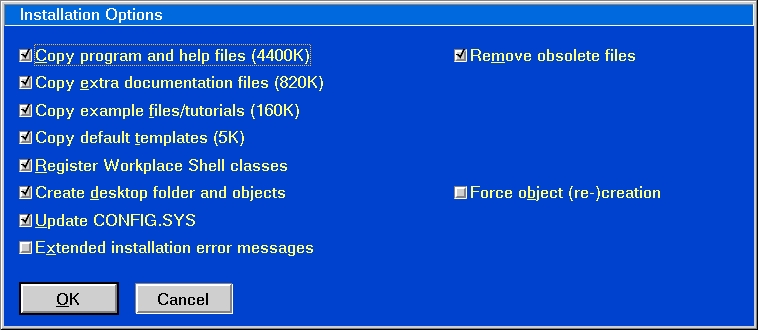
For those that feel a need to change the default installation settings, there's a few options you can set. I don't see much point though, I kept all the default settings and just let it go through.
Mesa should work on Warp 3 and up. I used my system which has MCP2 + fixpacks installed, and it was still very happy. So, total disk space installed? I count 5.6MB (hey, just like Sundial advertised!). Memory? Using Theseus, I saw an absolutely pitiful 4MB (again, just like advertised) which grew to about 7MB working on a graph-heavy sheet. Can you imagine if Microsoft Excel had this kind of efficiency?
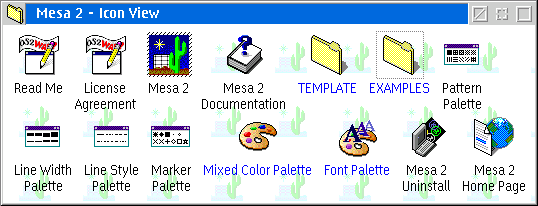
You get a bunch of stuff with Mesa, including on-line documentation, some example spreadsheets and even a couple of templates. You'll also see a bunch of new "palettes" in addition to the standard OS/2 colour and font palettes. As befits a proper OS/2 program, these new palettes look and behave just like the standard palettes (though I'm not sure any other applications can recognize the functionality from these).
As you might expect from such a lean program, Mesa fires up pretty quickly. By default, it opens up a demo / mini-tutorial. It's a nice introduction, and I wish more applications came like this.
Yes, and then that's it. It wasn't glossy or sexy. It sort of worked like every other spreadsheet. I played with it a bit, and it got left in the dusty corners of my hard drive.
Good thing that wasn't really the end of it. Several weeks later, with time on my hands, I started playing with it. Just for kicks, I did some real work on it in parallel with Lotus 1-2-3.
And the next day, I did it again...and again...and again...and pretty soon, I found myself firing up Mesa exclusively anytime I needed to get any work done. I was hooked. It's fast, stable and easy to get what I need to get done very easily. In a way, it parallels my experience with OS/2. Not terribly pretty, but once you get to know it and work with it, you realize it's much more efficient at getting things done.
Mesa is a great application with regards to user friendliness, in my opinion. It is not only easy to use, it usually sports multiple ways of doing the same thing, whichever is best for you. For example, just to change the font in a particular cell, you can go to the menu, right-click the mouse for a pop-up menu, open up a font dialog box, or drag 'n drop from the font palette. Best of all, all these methods have never gotten in my way as they remain separate and not at all confusing.
I don't want to say too much about the functions Mesa is capable of. It's pretty much standard spreadsheet stuff. No glaring holes that I recall, as of yet. I have yet to near its claimed capacity of 99,000 rows, 18,000 columns and 700 layers. Wow!
There is "smart" fill capability, range naming, and your usual stack of mathematical functions. Or maybe some unusual ones too. I was surprised to find Mesa can handle some matrix operations such as inversion and some really rare (at least for me) functions such as Bessel functions.
I really don't have any complaints in this department, and I suspect neither will you.
Rexx scripting: Microsoft likes to use Visual Basic. Lotus has Lotus Script, well, Mesa just uses MScript which is just an extension to good old Rexx! Is it any better or worse than VB or Lotus Script? Well...I guess some of you devotees would like to argue the finer points of each, but I think Rexx is far from being a bad choice and since OS/2 supports Rexx "natively", you can pull some pretty powerful tricks with Mesa and Rexx scripts.
Formula Builder: Okay, maybe you don't think it's so nifty, but I think it's pretty cool, and I don't remember seeing this in 1-2-3 or Excel. Just go to the menu "Edit->Formula builder...".
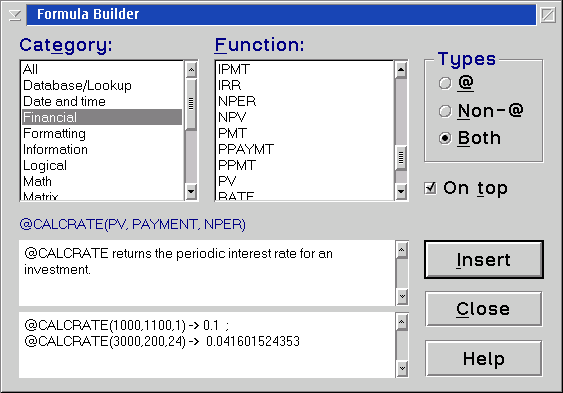
You get this handy little dialog to select and "build" the formula you need. Of course, the commonly used ones you can remember off the top of your head, but if you ever needed to search for more obscure one, this feature looks pretty handy.
Real-time feed: This one, I have to admit, is one of the coolest features. I haven't seen this in the other spreadsheets. It may be possible to do somehow, but it isn't "built-in". Essentially what this allows Mesa to do is grab data from "somewhere else" and provide a live update. If you go to Sundial Systems web site, you can download a stock feed example. It grabs the (free) stock quotes off Yahoo! and provides an on-going update in your spreadsheet. So, yes, if you had access to a real-time quote service, you could stream this to your spreadsheet, keep track of your portfolio. How handy!
Another use I've thought of for this feature is data-acquisition. I've got various instruments that can be hooked up to a computer. Using Mesa, this could be a cheap, easy way to, for example, make a computer-based oscilloscope. With Mesa's plotting and math capabilities I can provide live display and processing of data. Or maybe you need to monitor something on your plant floor. The uses for real-time feed are endless!
Nowadays, we have to live with the reality that most people run some other spreadsheet. Mesa would be no good if it only played by itself. Fortunately, Mesa handles most of the common spreadsheet formats, Excel, Quattro, 1-2-3 as well as text formats. Obviously, it is unlikely to handle special or complex features from each of those packages (I'm sure you know it's rare that different office applications play nice with each other).
During the time I was using it, I had to interact with various people using Excel. They weren't very complicated documents, but typical of what most people work on. I had no trouble at all opening their spreadsheets and I didn't hear any complaints from them when I sent them my work (saved as Excel spreadsheets).
It claims to support over 205 1-2-3 formulas and 215 Excel ones, so that's a pretty good reason why I didn't have any problems!
I also put it through some more stressful tests of mine (multi-sheet documents with plenty of charts and things), and Mesa fared pretty well. When it cames to charts, Mesa seemed to ignore them, but the data came out fine. At the same time, I tested 1-2-3 and StarOffice as well. They also imported pretty similarly, though sometimes the charts came through, sometimes it didn't. On the whole, I'd probably rather have it the Mesa way, where I know the charts aren't going to come through, rather than have something that may or may not be right.
I guess the summary is that Mesa seems to do no worse and no better than the other "big" spreadsheets.
Plotting is a big thing for me, which is why I have to say Excel is still king in this arena. It might be de-throned though by the latest version of Quattro I've played with, but unfortunately, none of these are on OS/2. So how did Mesa fare?
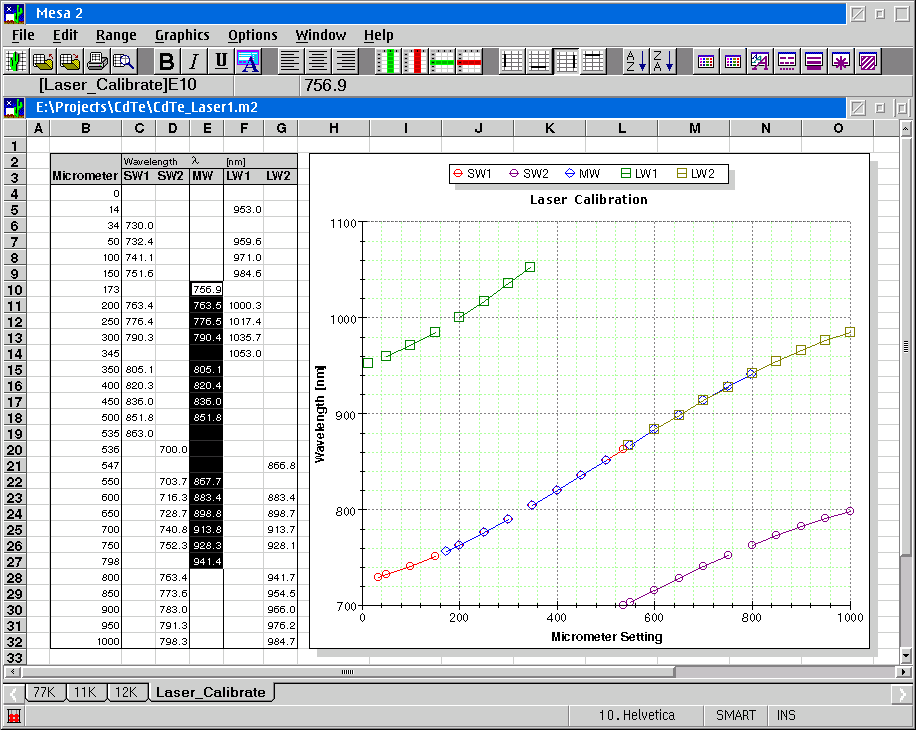
Above is an example of what I've been doing with Mesa. I primarily use it for scientific/engineering related work, so ease of plotting is of great importance to me. I've been going with Mesa instead of Lotus 1-2-3 because for multiple X-Y (scatter) plots, it is so much easier. Both support it, but in Lotus 1-2-3, you must have the data in contiguous columns. (i.e. X1 Y1 X2 Y2 ...). No such limitation in Mesa.

All you have to do with Mesa is go to the "Graphs" properties page. (Like any good OS/2 application, accessible from the menu bar or right-click mouse button). From there, you just need to specify which cells you want graphed. They can be totally different size, from anywhere on the current sheet, or even another sheet.
Mesa is even capable of some 3-D surface plots and simple animation of these plots. If you're really clever, you can even produce plots like this:
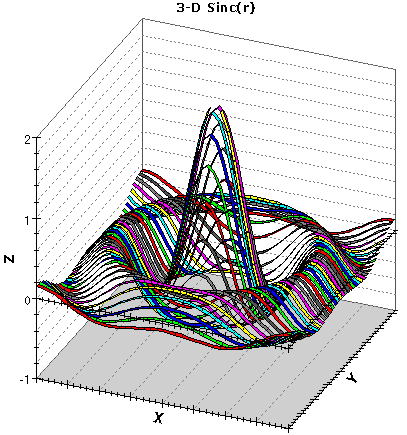
On the whole, I was pretty satisified with Mesa, I felt I got my money's worth, but that doesn't mean improvements can't be had. Here are some things I'd like to see improved/added:
As you can see, I'm getting pretty nitpicky. Probably won't happen, but if it does, it just makes a great product that much better. On the other hand, with a few minor changes, it could be an excellent scientific plotting package. The market is currently owned my XACT! which is really, really expensive. Another competitor would be welcome.
Mesa has been stable and pretty much flawless the whole time I've been using it. I especially like how it can auto-save a backup copy for me (not that I've needed it.
Unfortunately, Mesa has again been "shelved" on my hard drive. For one tiny little problem. When you delete layers, the data on your graphs doesn't get updated properly. Bad! It was months before I discovered this problem because it can be subtle. Because I have many similar layers, it wasn't obvious that some of my graphs pointed to the wrong data. It would've been better if it outright failed.
This has been reported to Mesa and others on the discussion forum have verified this behaviour. I'm not sure when it will get fixed, but for me, I'm afraid I've stopped using Mesa for now until it does. I can't afford to have bad data!
Frankly, I'm a bit surprised at the situation, because up to this point, Sundial has been very responsive to me. When I asked how it could do multiple X-Y plots, someone answered right away. When I discovered a special bug (turning on the Y-axis grid on a logarithmic graph in some particular sequence would hang OS/2), they immediately acknowledged it and provided me with a special build that fixed the problem within days! Try getting that kind of service from Microsoft!
Mesa, despite that one bug, is still a good product. If you don't constantly add and delete layers like I do, or rarely use charts, you won't have a problem at all. It is truly fully-featured, so you won't be missing out on anything by going to a pure, native OS/2 solution. You'll even be saving yourself disk-space, memory and CPU power.
Good thing is, a demo is available for download so you can try it out yourself. Given my experience, I advise you to work closely with it for a while. Use it on "real" topics. I think you'll find that it really is nicer to work with once you get over the initial learning curve.
References:
Mesa 2 2.3 from Sundial Systems |
Isaac Leung has written for the VOICE Newsletter in the past, and is currently very occupied with his position as Chief Editor for OS/2-eZine (http://www.os2ezine.com), one of the best online resources for the OS/2-eCS community.
Comments, suggestions about this article: Isaac Leung
[Feature Index]
editor@os2voice.org
[Previous Page] [Newsletter Index] [Next Page]
VOICE Home Page: http://www.os2voice.org